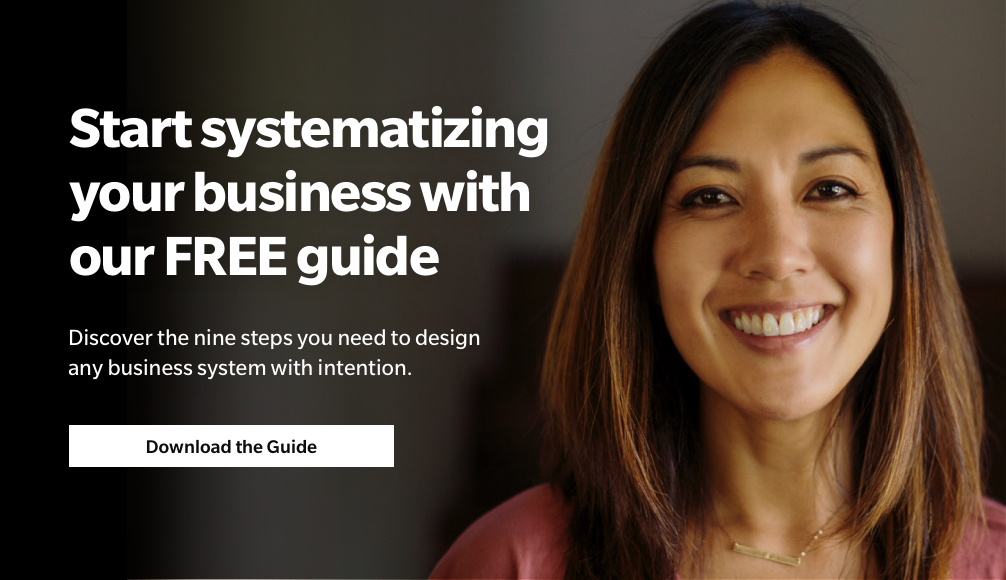Our natural world is a great example of systems at work—solar systems, ecosystems, weather systems, bodily systems, and so forth. As humans, we naturally look for patterns to solve problems and make extraordinary advancements. We search for ways to turn chaos into order and to discover efficient and repeatable ways of doing this to preserve our resources and energy. It is no different being an owner of a business. You want productivity, control, and predictability.
You may not have thought about it this way before, but the business you have right now is already run by systems—ways of doing business that pretty much happen the same way over and over again. If these systems were created by default, it’s likely they’re not producing outcomes you really want. No matter what results you want to produce in your business, the systems your business relies on must be created by design. Systems are the operating structure necessary to grow your business, sell it, pass it on, produce more income, and free yourself to both spend more time away from your business and also inside it doing what you love.
What do systems do for your business?
The connection between people and systems
Building a business that serves your life requires a deep understanding of the powerful interplay of people and systems. Carefully crafted systems produce consistent, predictable results. Thoughtfully engaged people bring an inspired, joyful, and genuine spirit to the systems, which enhances their effectiveness. When you bring people and systems together in the right relationship, the result is greater than the sum of its parts. It's a business that reflects your vision but doesn’t depend on you to get things done.
Systems create more life
Contrary to conventional wisdom, systems are liberating rather than confining. Systems leverage people at all levels of skill and experience to produce exceptional results. Systems generate consistency and predictability that eliminate overwhelm and boost the value of your business. They provide a means of transporting your values throughout your company. Systems will not only free you from your business, they’ll free you in your business to be the leader it needs you to be.
On time, every time, exactly as promised
Your customers are attracted to your business by the promise it’s made to eliminate a frustration or fulfill a desire. They’ll stay with you—and refer their colleagues, associates, family, and friends—if you keep your promise consistently, predictably, time after time. Employees come and go. Carefully-crafted systems make it possible for your business to keep its promise no matter who’s operating them.
The way we do it here
The ultimate reward of creating a system-based business is the predictability and consistency of the results you produce, regardless of whether you're there or not. They increase the value of your business exponentially. And if you’ve done a good job of understanding your customer, you’ve also created a proprietary way of doing business that sets you apart from your competitors. Think about Starbucks. They developed a highly personal way of making your favorite mocha coffee drink. They customize it (two shots, no whip, with one pump of chocolate); then the barista writes your name on the cup and calls it out as you wait in a comfy café environment. Systems create that experience, and you find it done the same way in every Starbucks you visit. For an online example, take Amazon. The site “remembers” you and always suggests relevant additional products based on your past purchase history, what you’re considering buying now, and what others like you have chosen. While the company is always innovating, the ordering and shipping processes haven’t changed since they started, giving customers an easy, familiar “store” they feel comfortable buying from.
How do you get started?
First, you need to shift how you see your business operations and begin to refer to the daily, routine tasks in terms of systems. A simple example is the task of answering your phone each day. This may be a task assigned to the position you call the “receptionist,” and there is a way you want the phone answered. This is your “Phone Answering System,” and it needs to be documented (possibly with a script or checklist) so that there’s a consistent experience for your customers no matter who answers the phone—if your receptionist happens to be out sick one day and another employee fills in, there will be an exact procedure for how to handle incoming calls.
There are many ways to begin identifying and naming the systems in your business. Consider the following options and pick one that feels right for you.
Experience your customer’s journey
This can be a very eye-opening exercise. Most owners get so busy working in their businesses, they forget to take the time to step outside it and experience it as if they were a prospective customer. When you do this, you directly engage with your systems (or lack thereof) and people to see what works and what doesn’t.
As you take this journey, you can note each and every step someone takes and all of the various components they come into contact with—people, information, and visual elements—as they investigate your business in search of the product or service they desire (your Marketing system). Then, if they are attracted to what you offer, they contact you or visit your physical location or website (your Lead Generation systems). Next, they may gather more information to compare your product or service (your Lead Conversion systems) with your competitors before deciding whether to make a purchase or not. Finally, they decide your business offers just what they need and purchase the product or service (your Customer Fulfillment systems). How do you provide service or support?
Follow your frustrations
Every frustration or problem in your business is simply the absence of a productive system. It may be that an existing system is broken or incomplete. Or maybe there’s a gap and no system was ever intentionally created. In this way, frustrations are actually good news. They are wonderful indicators and opportunities for seeing where systems need to be fixed or invented.
This new perspective—if adopted widely by every person in your business—becomes a game-changer. It eliminates finger-pointing, back-stabbing, and ends the blame game. Instead, everybody begins to look for system solutions and feels empowered to work on the business.
Review your organizational chart and positions
This is the approach we were working with earlier, when talking about the position of receptionist and your “Phone Answering System.” Each position in your company has a reason for being there and a set of tasks they are accountable for. At EMyth, we document these clearly with a management tool called a Position Agreement. You may have something similar that you call a job description. On that document, you probably listed the daily, weekly, and monthly tasks the position is responsible for doing. Each one of those tasks should have a corresponding system or a way of doing that task. If you go through your job descriptions (or Position Agreements) you can name the system for every task and build a position-specific operations manual. That is a very effective way to begin. Plus, like looking at frustrations, you engage your people in the systemization process.
Follow EMyth’s systemization model
Three decades ago, we created a proprietary model and process for developing a business that works. There are seven major functional systems in a business, designed to create an integrated whole and a seamless customer experience. Every business, large or small, performs these functions:
- Leadership
- Marketing
- Finance
- Management
- Customer Fulfillment
- Lead Conversion
- Lead Generation
The first four systems—leadership, marketing, finance, and management—are the disciplines that underlie your business strategy. These disciplines also make it possible for your customer-facing activities—lead generation, lead conversion, and customer fulfillment—to deliver on your promise.
As we said, your business has lots of systems but most are incomplete, have been developed randomly, and live inside your people. A cornerstone of our Coaching Program is this one-of-a-kind, systematic process for going through your business to identify, evaluate, and document your systems.
What are the components of a sustainable system?
As you go to work on systematizing your business operations, keep in mind these four components that are essential to creating and documenting systems that last. Each and every system should contain:
- A clearly defined result statement (to explain why the system exists)
- Standards of operating (to guide how people behave while operating the system)
- Key performance metrics (to measure the system’s effectiveness and drive innovation)
If you would like to learn more about systematizing your business check out our free 9 Step Business Systemization Guide. If you'd still like more help, sign up for a free business coaching session so we identify and assess your business needs.




Comments